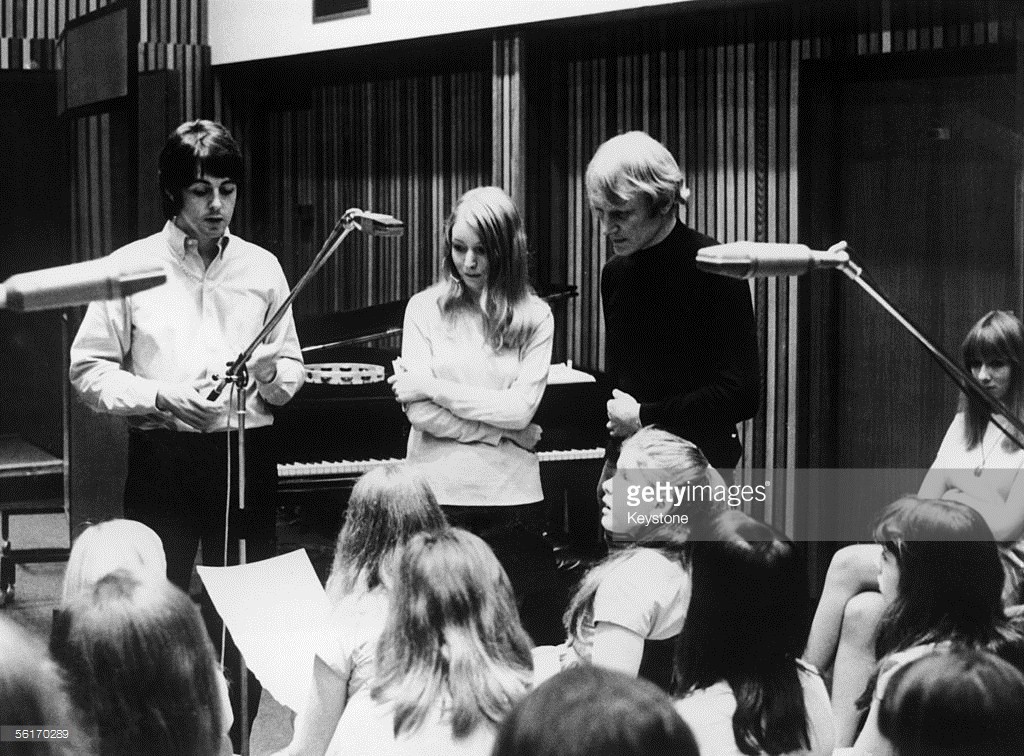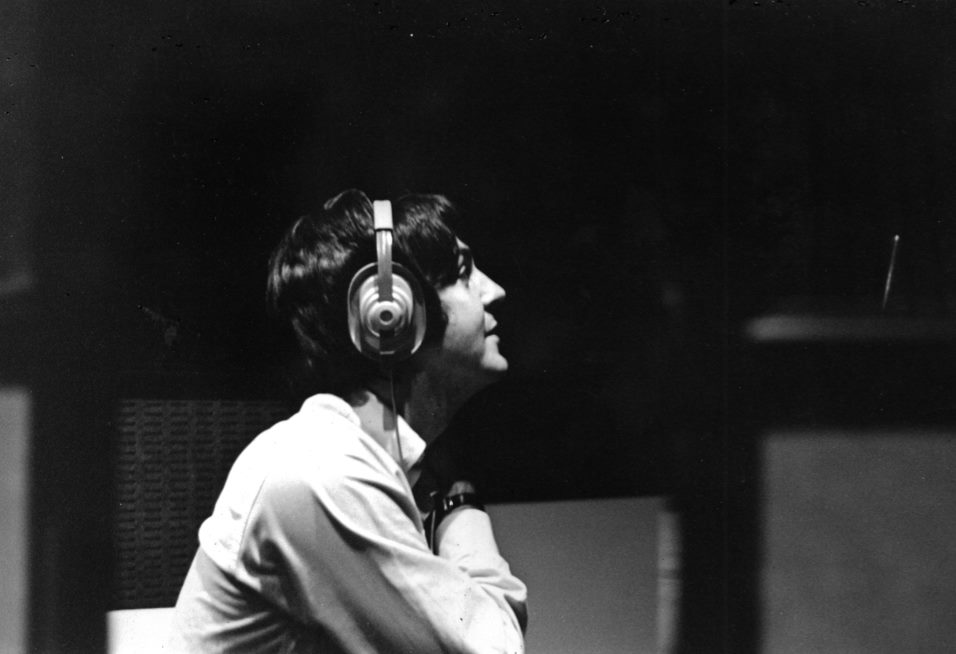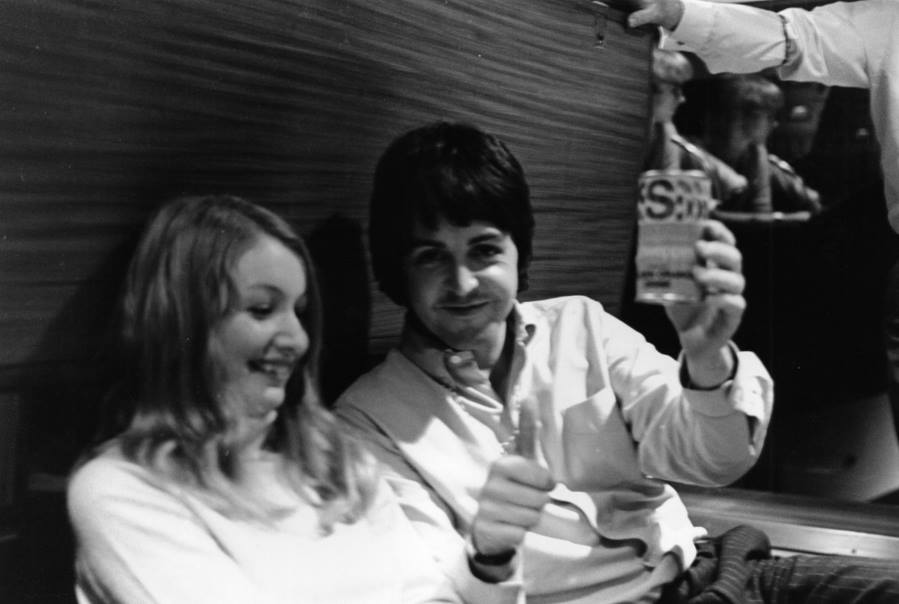Recording studio: EMI Studios, Abbey Road
Recording studio: Trident Studios, London, UK
Article Jul 15, 1968 • The Beatles move into the Apple headquarters at 3 Savile Row, London
Session Late July 1968 • Recording "Those Were the Days"
Session Jul 16, 1968 • Recording "Cry Baby Cry"
Some of the songs worked on during this session were first released on the "Those Were The Days / Turn! Turn! Turn!" 7" Single.
Paul McCartney discovered young Welsh singer, Mary Hopkin, through her participation in the TV talent show, “Opportunity Knocks”. For her first recording session, Mary recorded the song “Those Were The Days” which would become a number one hit on the UK Singles Chart. Paul produced this session.
Well… a long time early, maybe a couple of years ago, I’d first heard “Those Were The Days” when Gene (Raskin) and Francesca, American singers, sang it in the Blue Angel in London and I’d always remembered it.
I’d tried to get someone to record it because it was so good. I’d hope the Moody Blues might do it but it didn’t really work out and, later in India, I played it to Donovan who loved it, but didn’t get around to doing it.
We rang Essex Music, the publishers of the song, but they didn’t know anything about it other than that they owned the song. They had no lead-sheets, no demos. But David Platz of Essex, nice man, sent to America and we got the demo and everything.
I showed Mary how I thought the song should be done and she picked it up very easily — as if she’d known it for years.
At first though, she was singing it as if she didn’t mean it which was strange for Mary, very strange.
But it was her first time in the studio and it can be frightening. After a few tapes, I kept showing her the way she should sing it and generally worked on it and suddenly she got it and we just put a tambourine on it and went home.
Paul McCartney – Interview with Melody Maker, September 14, 1968
The recording was quite a momentous occasion for me. It was in Abbey Road Studios. There was a full orchestra there, which was quite intimidating. The song was fresh and new to me, even though I’d learnt it, so when we started recording I was very timid about it.
Paul would come in and say, ‘Think about the lyrics and who this person is.’ I wasn’t happy with what I’d done, so he said, ‘Go home and think about it and we’ll try again on Monday.’ Which I did. And in the meantime John Lennon rang me at home in Wales and said, ‘To err is human, to forgive divine. Just try again. You know you’ll do it.’ That was so sweet because Paul must have told him that I was nervous and didn’t quite get the take. That was such a lovely thing to do.
I went in on Monday and nailed it, they said… But I was more comfortable with it. Generally the song was about a much older person than I was. I was a little schoolgirl basically. Maybe that’s what worked with the song, the fact that I was almost a child, singing an older woman’s song. That’s what people liked about it. But I felt privileged to have been given that song by Paul.
Mary Hopkin – From Mary Hopkin Music
Richard Hewson was brought in to do the arrangement:
Stravinsky, Ravel, Miles Davis, Bill Evans, John Coltrane—I was studying orchestration and I was playing in a jazz band at the time,” Hewson recalls. “Peter Asher was a friend of Paul McCartney’s because Paul McCartney was going out with his sister at the time. I was at Peter Asher’s house and Paul was there with Jane and Peter said, ‘Oh Richard, Paul is looking for an arranger to do a record with this girl called Mary Hopkin. You can do arranging, can’t you?’ I said, ‘Of course I can,’ never having done an arrangement for a record before.
Richard Hewson – From Classic Track: “Those Were the Days,” Mary Hopkin (mixonline.com)
Apple was a funny old place. It was very haphazard. Nobody really knew what anybody else was doing! Peter didn’t know anything about arrangers. All he knew was he knew me, and that I’d been to the Guild Hall and studied classical music. And he thought, ‘Okay, so Paul wants some orchestra on this. Richard probably knows how to write classical orchestra arrangements, let’s try him.’ That’s how I got the job, cause they didn’t know anybody else. That was lucky for me. If they’d looked around, they could probably have found a real arranger.
Richard Hewson – From mcbeatle.de
When I went to Guildhall of Music, I knew Peter Asher. He and I were in a jazz trio, I was a total jazz head, knew nothing of pop music, I always thought Dusty Springfield was a cowboy- shows how much I knew! Anyway, Paul was going out with Jane Asher, Peter’s sister. While rehearsing at Peter’s house, I met Paul for the first time. So, Peter, who was working for Apple at the time, knew he was looking for someone and suggested me from college. I heard Mary Hopkin, must have been her and an acoustic guitar, and Paul gave me a free hand. And that was Those Were The Days
Richard Hewson – From Richard Hewson On Paul McCartney’s ‘Thrillington’ » We Are Cult
Paul was not really prescriptive when it comes to the arrangement, with the exception of using a cymbalom.
It’s a Hungarian instrument that is like a piano without the lid on, hit with hammers. That’s the ding, ding, ding sound you hear on the song. He said that’s all he had in mind, and, ‘After that, do what you like.’ So I wrote the arrangement, and not knowing pop music, that’s why it doesn’t sound like the pop music of the time.
Richard Hewson – From Classic Track: “Those Were the Days,” Mary Hopkin (mixonline.com)
It was an unusual instrument played with hammers, like a dulcimer. There was only one guy in England who could play one – one of my professors, Gilbert Webster. That’s who’s on that recording.
Richard Hewson – From mcbeatle.de
Geoff Emerick was the engineer on this session.
I think we took a day out of the Beatles’ schedule so Paul could do this. We did it in Studio Number 3, Abbey Road
Geoff Emerick – From Classic Track: “Those Were the Days,” Mary Hopkin (mixonline.com)
July 26, 1968, seems a likely date. It was a Friday and there was no Beatles session on this day (On Friday, July 25, the Beatles started recording “While My Guitar Gently Weeps“, and on Monday, July 29, they would start recording “Hey Jude“)
[The orchestra] was screened off to the best of my ability. We didn’t have any gigantic sound baffles. They were just sort of cheap things. Number 3 Abbey Road is not as big as Number 2, and it was a bit of a squeeze. I got the best separation I could get between the brass, the woodwinds and so forth.
Geoff Emerick – From Classic Track: “Those Were the Days,” Mary Hopkin (mixonline.com)
It’s likely Paul McCartney contributed acoustic guitar on the track, as remembered by Richard Hewson and Mary Hopkin.
I’m pretty sure Paul played guitar on the session
Richard Hewson – From Classic Track: “Those Were the Days,” Mary Hopkin (mixonline.com)
It’s hard to remember all the exact details from so long ago but here are a few answers for you. I did not play guitar on ‘Those Were the Days.’ Paul played acoustic guitar. Paul’s thigh slap was on my second single, ‘Goodbye,’ where he and I played the two rhythm guitars. I don’t recall who played the drums on ‘Those Were the Days,’ but since it was a full, orchestral arrangement [by Richard Hewson], I believe it was a session player, though Paul sometimes played additional drums [often enhancing Ringo’s basic pattern] on the Postcard album tracks.
Mary Hopkin – From Classic Track: “Those Were the Days,” Mary Hopkin (mixonline.com)
From Classic Track: “Those Were the Days,” Mary Hopkin (mixonline.com):
Both Emerick and Hewson recall that Hopkin was very shy and somewhat nervous.
“In the photograph of me, Paul McCartney and Mary in the studio, you can see her arms are folded tight around her body. Her body language shows she’s very nervous,” Hewson says.
Hewson says he does not recall that the recording of the orchestra took more than six attempts.
“I don’t remember it being like ‘The Long and Winding Road,’ which I did later with Phil Spector,” he says. “That was a madhouse. That job came through Paul very soon after.”
A personal memory for Hewson was when McCartney called him over at some point during the day. “He said, ‘Come over to lunch, I’m meeting Twiggy,’ so we all had lunch—Mary, Twiggy, Paul McCartney and me—and that was a big deal,” Hewson says.
Memories are vague on whether the track was cut all in one day or over the course of two, but the children’s choir, brought over from the Corona School, was recorded at Trident Studios.
“Whenever you wanted a choir of children on records back then you contacted an organization called the Corona School [Wikipedia has it as Corona Theatre School, which closed in 2013]. There would have been about 15 of them maybe,” says Emerick, who remembers that Trident had a mixing console of their own make and an 8-track. Emerick says he might have used C-12s on the children’s choir.
“It was different from everything around,” says Hewson, who remembers that the song hit Number 1 in England the day he got married the first time. “Part of why it was different I think is because I wasn’t a pop musician. It doesn’t seem like an American-type record at all.”
Hewson laughs as he reveals he was paid about 30 American dollars for his work on that record. “Arrangers don’t get royalties. They just get a fee. I got 25 pounds, which is about $30. But people said, ‘You got a career out of it, didn’t you?’ So I did get lots of gigs when it reached Number 1. My fee went up for ‘Long and Winding Road.’ I got $40 for that.” Seventy-one-year-old Hewson still plays music in the UK with the RAH Band (Richard A. Hewson), which still does records.
“So I guess that $30 started off my career that has kept me going all these years.”
We assume that “Turn! Turn! Turn!“, the B-side of “Those Were The Days“, was recorded around the same time, but have not found any evidence of that.




Written by Boris Fomin, Gene Raskin
Recording
Written by Pete Seeger
Recording

Notice any inaccuracies on this page? Have additional insights or ideas for new content? Or just want to share your thoughts? We value your feedback! Please use the form below to get in touch with us.
Jordache • 2 days ago
I think you're wrong about the 26th!
I think the session with the orchestra took place on Friday the 25th in the afternoon.
It is highly unlikely that a full orchestra would assemble in the studio during the weekend, to wit on Saturday, the 26th.
After Hopkin failed to record the vocal on the 25th, she succeeded on Monday the 28th (sans orchestre!)